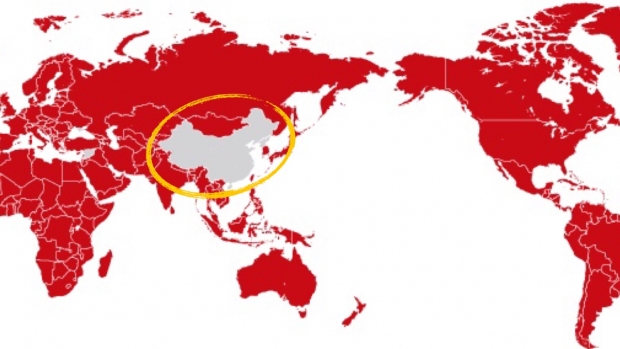Mainland China’s ban is Southeast Asia’s boon
Google “South China Sea,” and you’ll get an eyeful. The region is hot, and in a perverse case of art imitating life, the Southeast Asian content wars are mirroring the greater political wrangling and military rattling. The world is pivoting to Southeast Asia, and the entertainment industry is leading the charge. Before we dive into those waters, let’s orient ourselves with a global reference frame...
The big picture
In 2019, global film box office revenue reached a record $42.5 billion USD, despite weakened performance in North America, where combined ticket sales were $11.4 billion USD – a 4 percent decline from 2018's historic $11.88 billion USD. The global growth spurt was driven by an increase in foreign box office, where revenue came in at $31.1 billion USD – the first time revenue has crossed the $30 billion USD threshold. Profitable international markets included mainland China, Japan, South Korea, France, Germany, Russia, Mexico, Spain, Brazil, and Italy.
The coronavirus pandemic of 2020 continues to have a devastating impact on the global entertainment industry: most significantly on live performances, theatrical film exhibition, and theme parks. Large organizations are suffering financially, while smaller companies have gone out of business. Nevertheless, certain sectors of the entertainment industry — games and streaming video most notably — are not only surviving, but thriving. Theater closures have increased the demand for home entertainment. As a result, gaming continues to grow and disruptive online streaming services like Netflix have become the “New Normal.” Even traditional film studios such as Disney are now prioritizing their streaming services.
The rise of Bilibili
Bilibili was born in 2009 as a forum for gaming and anime fans like its creator Xu Yi, but it was current Bilibili chief executive Chen Rui who elevated the forum into a legitimate business in 2014 — cleaning up bootleg content and investing millions of USD into broadcast rights while expanding into live streaming, e-commerce, and lucrative game publishing. In the process, Chen secured investments from both Tencent and Alibaba — a notable accomplishment when aspiring content providers typically ally themselves with one platform or the other.
Investors in China and around the world are flocking to Bilibili as a way to tap the growing buying power of China's “Gen Z” demographic, which has supercharged startups like toy maker Pop Mart. (It is estimated that nearly 90 percent of Bilibili’s users were born after 1985.) In addition to heavyweight content related to League of Legends and NARUTO, Bilibili users currently create and consume grassroots content ranging from rap hooks to life hacks and everything in-between — attracting the attention of Western tech giants like Apple CEO Tim Cook.
Bilibili’s recent debut on the Hong Kong stock exchange marked another milestone for the red-hot streaming service. Bilibili's stock more than quadrupled over the past year in the USA, as the platform emerged as an unexpected disruptor in global streaming and social networking. Bilibili chief executive Chen Rui declared that his company will use most of the proceeds to invest in creators and content, anticipating an exponential growth in streaming adoption over the near term. With nearly one billion internet users in mainland China, Chen’s strategy to capitalize on the streaming video mega-trend seems right on target.
The West responds
Western media companies such as Disney and Netflix have taken notice, and are not ready to cede their piece of the Asia Pacific streaming video pie. Over the past few years, Netflix has unveiled a raft of original Asian productions in Japan, Taiwan, Thailand, India, and South Korea, in addition to growing its content slate in India. Netflix CCO Ted Sarandos observed, “Asia is home to the world's great creative centers producing some of the most compelling films and series of today.”
Netflix is presently doubling its expenditure on original content in APAC in an attempt to stay competitive in a crowded streaming market including the likes of Chinese billionaires Pony Ma and Richard Li. The global popularity of shows like the Korean zombie period thriller Kingdom has further fueled Netflix’ ambitions. The streamer has reportedly spent almost $2 billion USD since 2018 on original and licensed Asian content, across more than 200 original titles.
When it comes to the APAC territories, Netflix has a watchful eye not only on Western rivals like Disney+ and Amazon Prime, but also on native competitors like Pony Ma’s WeTV and Richard Li’s Viu. All players are currently trying to lure users with cheap subscription packages — operating at a strategic loss in order to secure market share in light of intense regional competition — at the same time as local regulatory scrutiny increases. (Netflix was accused of tax evasion by the Vietnam government.)
Fueled by the impact of the global coronavirus pandemic, streaming revenue in Asia Pacific (excluding mainland China) is projected to more than double to $15 billion USD by 2025. Netflix currently claims the largest slice of that pie, with a 35% share of streaming revenue in the region (excluding mainland China, where the platform is banned). Netflix is actively expanding in content investment across India and Southeast Asia: notably in Thailand and Indonesia.
Challenges emerge
Not to be outdone, mainland China’s biggest online video platforms — Tencent and iQiyi — are aggressively expanding in Southeast Asia, in direct competition with Netflix and Disney. The increased focus on Southeast Asia represents Tencent and iQiyi’s most significant efforts outside of mainland China. Given that both Netflix and Disney+ are banned in China due to regulatory restrictions over foreign media ownership, Southeast Asia has become the de facto battleground for the Sino-U.S. struggle over global storytelling dominance.
That said, the Southeast Asia market presents thorny challenges for any global entertainment company. Outside of relatively affluent pockets such as Singapore, most people in the region earn less than $10,000 USD a year on average. Indonesia — the region’s most populous nation — is home to a variety of cultures, hundreds of languages, and strict censorship rules. Netflix’ initial forays into Southeast Asia were hampered by perceptions that it was too expensive, dismissive of local languages, and tone-deaf to regional cultures — perceptions that Netflix has addressed recently by selling cheaper, mobile-only plans and investing in local content development. As a result, Netflix now has nearly 1,000,000 subscribers in the Philippines, and more than 600,000 subscribers in Thailand — second only to local provider Line TV.
Good times ahead?
It’s a great time to be a content creator — especially if you hail from Southeast Asia. Where once the eyes of the Western world were solely on mainland China, international media companies are seeking new Asia Pacific creators, vendors, and production partners due to the impact of politics and the pandemic. From Malaysia’s local animation hit Ejen Ali to Disney’s Raya and the Last Dragon, the South China Sea is boiling.
Prospects may seem daunting with so many big fish in the water, but as in usually the case — opportunity will not necessarily go to the fastest, the biggest or the strongest, but to the most creative. Our venture in Taiwan — tellretell — is predicated upon that.
















